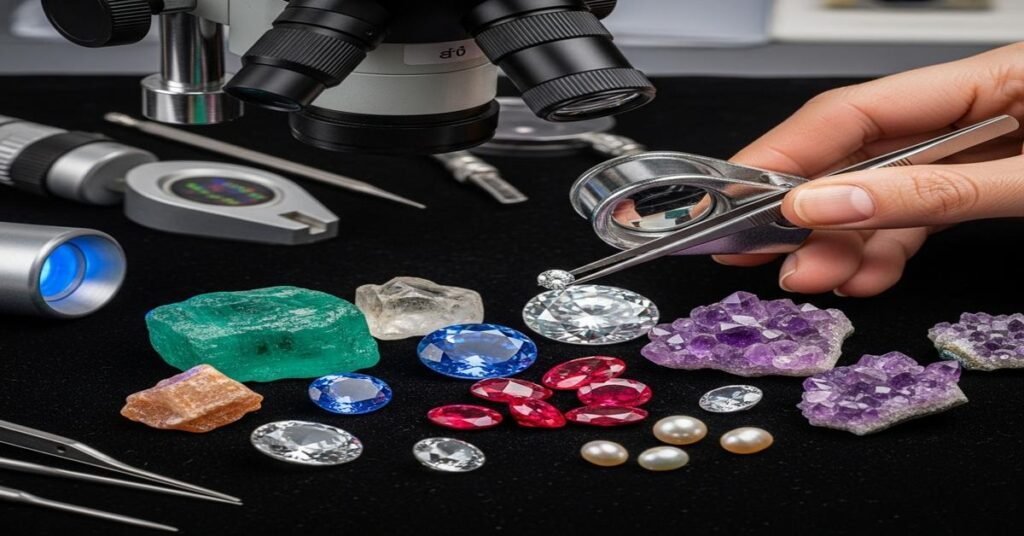A career in gemology blends science, hands‑on skill, and the business of gems and jewellery. In India you can move from inspecting a 0.5 ct diamond under a loupe to certifying 10 ct sapphires with spectroscopy. This article explains practical steps, course types, likely salaries, and realistic career paths so you can decide if gemology fits your strengths and ambitions.
What gemologists do — clear and concrete
Gemologists identify and grade gemstones, test for treatments and synthetics, and prepare reports used by retailers, auction houses, and exporters. Work ranges from:
- Diamond grading — assessing the 4Cs (carat, cut, color, clarity). For example, a 1.00 ct round brilliant diamond has ~6.5 mm diameter; grading includes assessments down to inclusions visible at 10x magnification.
- Colored‑stone identification — distinguishing sapphire, spinel, and treated corundum using refractive index and microscopic inclusions.
- Testing treatments and syntheses — detecting heat treatment, fracture filling, diffusion, HPHT for diamonds, or glass filling in garnets.
- Appraisal and valuation — pricing jewellery using metal content (18K = 75% gold) and gemstone quality, plus market factors.
- Quality control and buying — working for retailers, exporters (Mumbai, Surat, Jaipur), or mining companies to set buying standards.
Course types and what they teach
Courses range from short certificates to full professional credentials. Hands‑on time with instruments is the most important factor.
- Short courses (2–6 weeks) — introduction to gemstone ID, loupe work, basic tools like refractometer and polariscope. Good for retail staff or assistants. Fees typically low (₹10,000–50,000).
- Diploma/Certificate (3–12 months) — more lab work, systematic training on inclusions, spectroscopy, and basic appraisal. Often includes an internship with a jewellery house or lab.
- Graduate professional courses (4–12 months) — international credentials (for example, Graduate Gemologist level from major institutes) cover diamond grading, colored stones, and report writing. These are more expensive but carry strong industry recognition.
- Specialist training — advanced spectroscopy (Raman, FTIR), pearl grading, or diamond treatments. Useful if you want a laboratory role or research focus.
Key skills and lab equipment you must master
Employers look for practical skills more than theory. Learn to use and interpret results from:
- 10× loupe and gem microscope — for inclusion patterns and surface features.
- Refractometer — measures refractive index to identify many stones.
- Polariscope, dichroscope, spectroscope — for birefringence, pleochroism, and absorption features.
- Advanced instruments — FTIR, Raman, UV‑Vis, and gemological XRF for metal analysis in appraisals.
- Soft skills — report writing, clear photography of inclusions, negotiation for buyers, and understanding market pricing.
How to choose the right course — practical checklist
- Hands‑on hours — prefer programs with at least 100 hours on microscopes and instruments.
- Internship/placement — useful for entry into trading hubs like Mumbai or Jaipur.
- Accreditation and recognition — international credentials or affiliations are valuable if you plan to work with export houses or labs.
- Faculty and lab facilities — check for modern instruments (Raman, FTIR) if you want lab work.
- Alumni outcomes — ask for sample placement lists and live project examples.
Typical timeline to become job‑ready
Here is a practical route you can follow in 12–24 months:
- Months 1–3: Short courses + buy a 10× loupe and practice identifying stones at a local market.
- Months 3–9: Enrol in a diploma or graduate course with strong lab hours.
- Months 9–12: Internship at a jewellery house, grading lab, or exporter. Build a portfolio of reports and photos.
- Months 12–24: Specialise (diamonds, colored stones, or advanced instrumentation). Obtain an internationally recognised credential if possible.
Salary expectations and career scope in India
Salaries vary by city, employer, and qualification. These are realistic ranges in current market conditions:
- Entry level (retail assistant, basic gem ID) — ₹2.0–4.0 lakh per year. Small shops and local dealers often start here.
- Diamond grader / junior lab technician — ₹3.5–6.0 lakh per year. Internationally recognised credentials or lab experience raise pay.
- Experienced gemologist / appraiser / buyer — ₹6.0–12.0 lakh per year. Roles include head of quality control, export buying, or senior appraiser.
- Senior specialists / lab managers / consultants — ₹12.0 lakh and above. Freelance consultants or international lab leads can earn significantly more depending on clients.
Also consider variable income: commission on purchases, freelance appraisal fees, or starting a trading business. These can raise earnings but increase risk.
Where you can work
Primary hubs in India: Mumbai (retail and exporters), Surat (diamond cutting and polishing), and Jaipur (colored stones and cutting). Other opportunities include:
- Independent gemological labs and certification houses
- Retail chains and boutique designers
- Auction houses, museums, and universities
- E‑commerce and luxury brands needing quality control and content (product descriptions, photos)
Advancement and future trends
Specialise to advance. Certified expertise in lab‑grown diamonds, treatment detection, or Raman/FTIR analysis commands higher pay. Traceability, blockchain provenance, and sustainability demands are growing. Buyers and brands need certified reports and trustworthy suppliers. That raises steady demand for trained gemologists, especially in export and branded retail sectors.
Final practical tips
- Start with a loupe — it sharpens observation before investing in expensive courses.
- Prioritise hands‑on training over long theoretical courses without lab time.
- Network — visiting gem marts, trade shows, and local labs helps you find internships and mentors.
- Keep learning — new treatments and synthetics appear often; short specialist courses keep you current.
Gemology in India offers practical, steady careers if you commit to instruments, training, and trade contacts. Start small, build lab skills, and specialise; the combination of solid credentials and hands‑on experience opens the most doors.
I am G S Sachin, a gemologist with a Diploma in Polished Diamond Grading from KGK Academy, Jaipur. I love writing about jewelry, gems, and diamonds, and I share simple, honest reviews and easy buying tips on JewellersReviews.com to help you choose pieces you’ll love with confidence.

